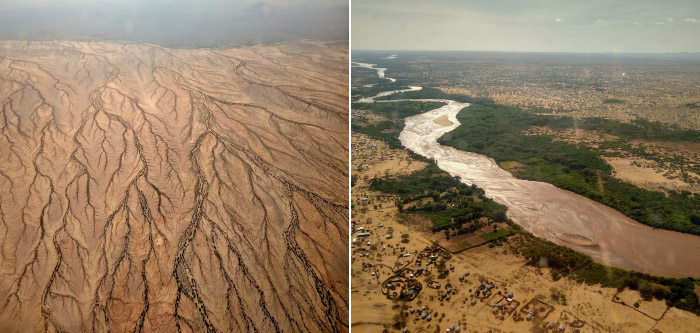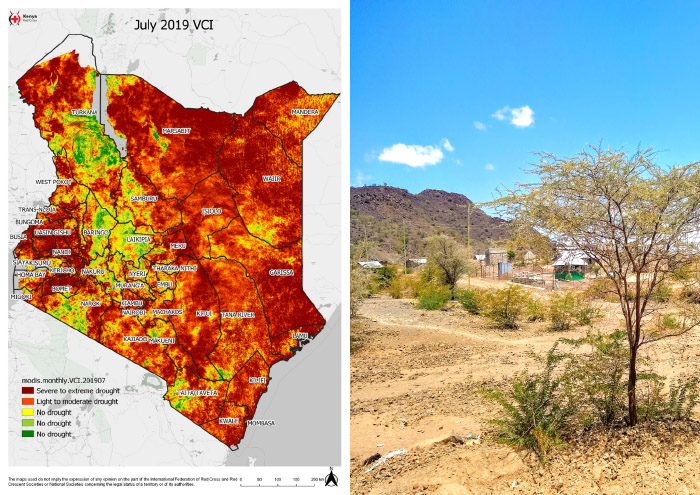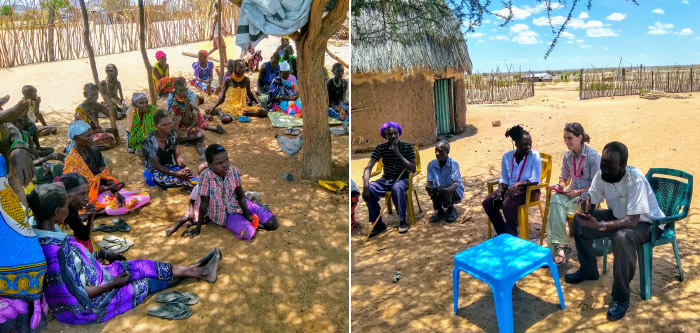 |
 |
 |
 |
notes from the field
This is a personal blog and does not reflect the views of the Red Cross Red Crescent Climate Centre
Sarah Posner
Kenya
June - September, 2019
“We are here through God’s will”: Experiences of Drought in Turkana County
September 2019
View photo gallery for more photos in the field by Sarah Posner
I peer out the window of the turbulent plane that dips up and down in the hot air. Below lay a series of dendritic tributaries that spread like fingers across the dry landscape. I am on my way to Lodwar, Turkana to collect primary data on the impacts of drought on the ground. Turkana is the largest county, located in the furthest corner of northwestern Kenya, and is believed to be the birthplace of humanity where archaeologists found the oldest skeletal remains of the famous ‘Turkana boy’. I am meeting with key stakeholders who engage in disaster risk management as well as attending a focus group discussion with members of a local Turkana community experiencing the drought first hand. The aim of the trip is to formulate a case study that will be presented at the upcoming national dialogue, which brings together county and national government officials, NGOs, and donors to discuss implementation of the Forecast based Financing system.
It hasn’t rained for months in many parts of Kenya, with two consecutive failed rainy seasons, which has put 2.6 million Kenyans at risk of food insecurity (Daily Nation, 2019). This is a significant increase from the estimated 1.6 million people that was established in May 2019 (NDMA, 2019). The situation is especially bad in this hot, remote and arid area of the country, where pastoral societies have beared the brunt of the impacts, many facing starvation. These counties include Turkana, as well as Mandera, Baringo Wajir, Garissa, Marsabit and Tana River in the pastoral livelihood zones, plus Kitui, Makueni, Kilifi, Meru North in the marginal agricultural and agro-pastoral areas (NDMA, 2019).

Left photo: Aerial view of the landscape of Turkana county. Right photo:The Turkwell river that runs through the city of Lodwar. Photo credit: Sarah Posner.
When I arrive in Lodwar, the temperature is 36°C (about 97°F), and the sun beats down on my shoulders. I squint my eyes and make out a Landcruiser approaching in the distance bearing the Kenya Red Cross Society (KRCS) emblem. The car grinds to a halt, kicking up dust. A woman by the name of Rakodia steps out of the passenger side to greet me, who is the director of the cash transfer program at the Turkana Red Cross branch. Rakodia will be supervising my stay here in Turkana. She welcomes me with a warm smile, a firm handshake, and we get in the car and head over to the branch office. There, I meet the county coordinator, Nicholas Thuo, who has scheduled the various interviews I will be conducting throughout the course of the day.
First on the list is a meeting with an officer named Dennis from the National Drought Management Authority (NDMA). The NDMA is an agency of the Government of Kenya mandated to establish mechanisms which ensure that drought does not result in emergencies and that the impacts of climate change are sufficiently mitigated in the arid, drought-prone counties of Kenya (NDMA, 2019). We meet to discuss data availability and limitations to forecast drought, which is at the forefront of work by the NDMA. During the meeting, we discuss the use of the Vegetation Condition Index (VCI) for drought monitoring. The VCI gives an idea where the observed value of vegetation condition is situated between the extreme values (minimum and maximum) compared to previous years. Expressed as a percentage, lower values indicate bad vegetation while higher represent good vegetation conditions, which are standardized internationally. However, the lack of specificity within the VCI is one drawback of the measure as it covers all vegetation types, even those unpalatable to livestock. This is problematic in the case of Turkana where Prosopis, an invasive species of mesquite, has greened the landscape but is not edible for livestock and is often referred to as a “dryland demon” by locals. As the map in Figure 1 shows, Turkana appears to have relatively good vegetation conditions compared to its neighbors due to the coverage of Prosopis.
This masks the reality of the situation on the ground, as the county continues to suffer a devastating drought that is killing off livestock. Thus, I learned from seeing the landscape first-hand that using the VCI for drought monitoring has drawbacks as it paints greener pastures than the reality of the situation on the ground.

Figure 1 (left): Severe drought indicated in red while shades of green depict less drought. Right photo: The shrub-like Prosopis under an acacia tree dots the landscape. Photo credit: Sarah Posner. Maps created by Steve Kenei part of the KRCS data preparedness.
Next, we travel to a remote village along a dusty road to engage in a focus group discussion with the local Turkana people. I am met by a larger group than I was expecting of about 25 to 30 people of all ages, ranging from grandmothers to young children, sitting in a half circle under the shade of an acacia tree. The community is excited to have a new visitor, and I am greeted with a warm welcome. I introduce myself and describe my intentions for the visit, which is to hear from the locals about their first-hand experience of the impacts of the unfolding drought in their area. A translator is there to help relay the message in Turkana, the local dialect spoken by the community.
An older gentleman stands up, acting as the representative for the community and begins: “We have many stories about drought, more than 10 problems. I will only speak of one problem for now, and let others tell their stories.”
“We are here through God's will, but the big problem we face is water. There is no water here, and the only source we are getting water from is the river.” He points in the distance, referring to the Turkwell river, located several kilometers away. He continues, “The young people fetch water from there, but the old people will not drink there. The trekking distance is far, and one injured his leg in the rocky river bed when he went to fetch water just the other day. This is one problem we face, that is access to a water source.”
A younger man in a powder blue, button down shirt now stands; it is his turn to tell his story, “Poverty is the big one. Before we were eating wild fruits, but now we can't use that formula. The community wants now drugs for our animals. Another problem we face is animals, they were our solutions to our problems. But the drought took them all, even one community member does not have any goats. Before, my father was killing animals like goats, cattle, and sheep when visitors come when there was lots of livestock, but we can't even compare to the situation now.”
He steps back and another woman, as if on cue, steps forward, wearing a traditional beaded necklace and a conga cloth wrapped around her waist.
She begins, “We have sickness because there is no hospital here. When you get sick here the way to get treatment is only found in Lodwar town. Now we are bankrupt from animals lost in drought and the district hospital will not assist you without payment. When scorpions bite, there is no treatment. We have no money for school books and the primary schools are far from here. Even our children are not going to school because when you take them to school, they don't have anything to feed them.”
Another community member, a mother who looks to be in her mid-40s steps up next.
“This is our place. This place is dry and a place of hunger. Some of the mothers are inside dying from hunger, they are merely surviving. Children are going hungry. The old fathers have children whose mothers have died, and old mothers won’t reach out to get food. They don't have the energy to go and get assistance. The hospital is too far from here. We want to be assisted like the others, but God is fighting for us. Water, hunger, sickness, there is no close hospital here, these are the main problems we face. We are here through God’s will only.”
Calendar of events
We decide to shift focus to discuss the calendar of drought events. Rakodia, who has much experience engaging in community dialogues, redirects the attention of the group to reflect on the droughts they can remember. Individuals chime in left and right, listing off the recent events, which the translator summarizes:
“The rain is inconsistent here, and comes and goes every 2 to 5 years. When it rains in 3 months we don't have a drought, in other months when drought is started, even the camel milk runs dry.”
The locals describe the signs a drought is coming, which the translator explains, “we can tell rain is coming when there are more butterflies flying and when the clouds change. This occurs typically every 2 to 3 years.”
The most recent drought, according to locals, started in 2014, with the failure of two consecutive rainfall seasons at the end of 2018. 1992 to 1994 were dry years as well. This year there is more drought, and 2019 has been a dry year.
Finally, the community describes the coping strategies to mitigate hunger during drought periods, “During drought we normally eat once a day. Before drought, we were eating 2-3 times a day, but that depends on the capacity of the household, whether they are poor or middle income. During drought, we sometimes only eat cereals.”
Community members mentioned consuming wild fruits as a coping strategy, specifically a palm fruit called makoma was foraged in moderation, as the fruit causes diarrhoea when consumed in excess. They also mentioned chewing branches of the miswak tree, often used to clean teeth that provides additional nutrients.

Left photo: Community members in Turkana village, Right photo: My supervisor Rakodia to my left and the translator to the right. Photo credit: Sarah Posner.
Overall, the trip was very informative and allowed me the opportunity to see (and experience) first-hand, the impacts of droughts. I also gained insights into the ecological factors that add complexity in forecasting drought impacts. This knowledge on the ground is something one cannot capture in a Google search.
Drought is a reality for the Turkana people, who have lived here since the beginning of mankind and found ways to adapt and coexist with this harsh landscape for centuries. With the onset of climate change, it is imperative to build the resilience of these vulnerable communities’ livelihoods who are on the forefront of related impacts that affect all sectors of society including food security, water, health, and education. I look forward to discussing these issues at the national dialogue later this month.
Daily Nation, (2019) Kenya drought: 'My son starved to death.’
National Drought Management Authority (NDMA), (2019).

